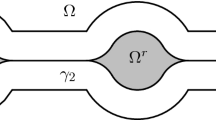Abstract
In this paper we prove a quantitative version of the classical isoperimetric inequality in the hyperbolic space \(\mathbb {H}^n\). The constant only depends on the dimension and an upper bound for the volume of the set.
Similar content being viewed by others
References
Acerbi, E., Fusco, N., Morini, M.: Minimality via second variation for a nonlocal isoperimetric problem. Commun. Math. Phys. 322(3), 515–557 (2013)
Almgren, F.: Optimal isoperimetric inequalities. Indiana Univ. Math. J. 35(3), 451–547 (1986)
Barchiesi, M., Cagnetti, F., Fusco, N.: Stability of the Steiner symmetrization of convex sets. J. Eur. Math. Soc. 15, 1245–1278 (2013)
Bernstein, F.: Über die isoperimetrische Eigenschaft des Kreises auf der Kugeloberfläche und in der Ebene. Math. Ann. 60, 117–136 (1905)
Bögelein, V., Duzaar, F., Fusco, N.: A sharp quantitative isoperimetric inequality in higher codimension. Atti Accad. Naz. Lincei Rend. Lincei Mat. Appl. 26(3), 309–362 (2012)
Bögelein, V., Duzaar, F., Fusco, N.: A quantitative isoperimetric inequality on the sphere (2013) (preprint)
Bonnesen, T.: Über das isoperimetrische Defizit ebener Figuren. Math. Ann. 91, 252–268 (1924)
Cianchi, A., Fusco, N., Maggi, F., Pratelli, A.: On the isoperimetric deficit in Gauss space. Am. J. Math. 133(1), 131–186 (2011)
Cicalese, M., Leonardi, G.P.: A selection principle for the sharp quantitative isoperimetric inequality. Arch. Ration. Mech. Anal. 206(2), 617–643 (2012)
Cicalese, M., Leonardi, G.P., Maggi, F.: Sharp stability inequalities for planar double bubbles (preprint). arXiv:1211.3698
David, G., Semmes, S.: Quasiminimal surfaces of codimension 1 and John domains. Pac. J. Math. 183(2), 213–277 (1998)
Duzaar, F., Steffen, K.: Optimal interior and boundary regularity for almost minimizers to elliptic variational integrals. J. Reine Angew. Math. 546, 73–138 (2002)
Figalli, A., Fusco, N., Maggi, F., Millot, V., Morini, M.: Isoperimetry and stability properties of balls with respect to nonlocal energies. Commun. Math. Phys. 336(1), 441–507 (2015)
Figalli, A., Maggi, F., Pratelli, A.: A mass transportation approach to quantitative isoperimetric inequalities. Invent. Math. 182(1), 167–211 (2010)
Fuglede, B.: Stability in the isoperimetric problem for convex of nearly spherical domains in \(\mathbb{R}^n\). Trans. Am. Math. Soc. 314(2), 619–638 (1989)
Fusco, N., Julin, V.: A strong form of the quantitative isoperimetric inequality. Calc. Var. Partial Differ. Equ. 50(3–4), 925–937 (2014)
Fusco, N., Maggi, F., Pratelli, A.: The sharp quantitative isoperimetric inequality. Ann. Math. (2) 168(3), 941–980 (2008)
Hall, R.R.: A quantitative isoperimetric inequality in \(n\)-dimensional space. J. Reine Angew. Math. 428, 161–176 (1992)
Hall, R.R., Hayman, W.K., Weitsman, A.W.: On asymmetry and capacity. J. d’Analyse Math. 56, 87–123 (1991)
Kinnunen, J., Korte, R., Lorent, A., Shanmugalingam, N.: Regularity of sets with quasiminimal boundary surfaces in metric spaces. J. Geom. Anal. 23, 1607–1640 (2013)
Maggi, F.: Sets of Finite Perimeter and Geometric Variational Problems. An Introduction to Geometric Measure Theory. Cambridge Studies in Advanced Mathematics, vol. 135. Cambridge University Press, Cambridge (2012)
Schmidt, E.: Beweis der isoperimetrischen Eigenschaft der Kugel im hyperbolischen und sphärischen Raum jeder Dimensionszahl. Math. Z. 49, 1–109 (1943/1944)
Tamanini, I.: Regularity results for almost minimal oriented hypersurfaces in \(\mathbb{R}^n\). Quaderni del Dipartimento di Matematica dell Universit‘a di Lecce 1, 1–92 (1984)
White, B.: A strong minimax property of nondegenerate minimal submanifolds. J. Reine Angew. Math. 457, 203–218 (1994)
Acknowledgments
We acknowledge the warm hospitality of the Institut Mittag-Leffler in the Fall 2013 during the program “Evolutionary problems”, where parts of this paper were written.
Author information
Authors and Affiliations
Corresponding author
Additional information
Communicated by L. Simon.
Appendix: Elementary facts in hyperbolic space
Appendix: Elementary facts in hyperbolic space
Here we give the proofs of certain facts we used in the course of the slicing lemma. We use the notation from the proof of Lemma 3.3 without any further explanation.
Lemma 7.1
The function
is strictly increasing.
Proof
Because of the strict monotonicity of \(\mathbf {v}(r)\) it is equivalent to show that
is increasing in \(r>0\). Using the identities
(cf. (3.17)), we compute that \(h'(r)>0\) is equivalent to
which, taking into account that \(\mathbf {v}'(r)=\mathbf {p}(r)\), is equivalent to (2.10). \(\square \)
Lemma 7.2
The expression
is increasing in \(r>0\) for every \(s\in (0,1)\).
Proof
We begin by calculating
It therefore suffices to prove that the function
is decreasing for every \(s\in [0,1]\). A straightforward calculation yields that \(f'(y)<0\) is equivalent to
But Lemma 7.1 implies that the right-hand side is increasing in y. Since \(s\in (0,1)\) and \(y>0\), we infer the asserted estimate (6.25) and thereby complete the proof of the lemma. \(\square \)
Lemma 7.3
For any \(r>0\) we have
Proof
We first note that it is enough to prove the integrability of \(1/\psi _r\) in a neighborhood of the singular points 0 and 1. Therefore, we consider \(s\in [0,\frac{1}{2}]\). By the mean value theorem there exist \(\xi _1\in [0,s]\) and \(\xi _2\in [1-s,1]\) such that there holds:
We now choose \(s_o\in [0,\frac{1}{2}]\) in dependence of r small enough to have
Then, for \(s\in (0,s_o]\) we find that
Next, we note that for \(0\le \sigma \le 1\) we have \(\cosh \sigma \le 2\) and therefore we have
Integrating both sides with respect to \(\sigma \) over (0, t), we obtain for \(0\le t\le 1\) that
Assuming that \(\mathbf v^{-1}(s\mathbf {v}(r))\le 1\), an assumption which can be imposed after possibly reducing the value of \(s_o\), we can use the preceding estimate in (6.26) to infer that for all \(s\in (0,s_o]\)
But this ensures that the integral \(\int _0^{s_o} 1/\psi _r \,ds\) is finite and by symmetry we also have that \(\int _{1-s_o}^1 1/\psi _r \,ds = \int _0^{s_o} 1/\psi _r \,ds<\infty \). This finishes the proof of the lemma. \(\square \)
Rights and permissions
About this article
Cite this article
Bögelein, V., Duzaar, F. & Scheven, C. A sharp quantitative isoperimetric inequality in hyperbolic n-space. Calc. Var. 54, 3967–4017 (2015). https://doi.org/10.1007/s00526-015-0928-9
Received:
Accepted:
Published:
Issue Date:
DOI: https://doi.org/10.1007/s00526-015-0928-9



